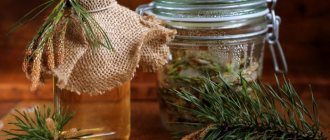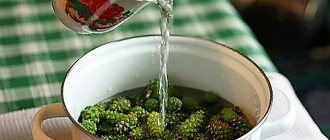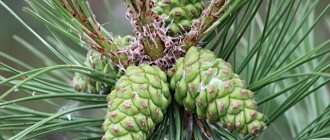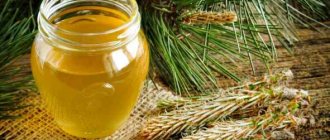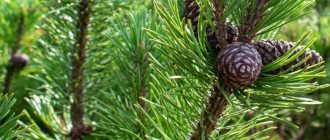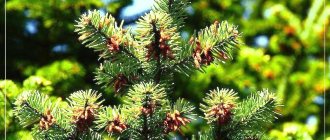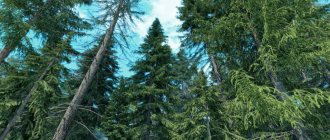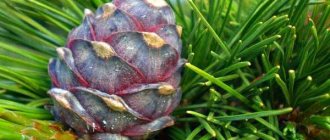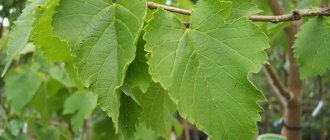Treatment with spruce needles
Pine tea is distinguished by a high content of essential oils, which give it a pleasant aroma and have anti-inflammatory and antibacterial effects. These properties are especially useful in the autumn-winter period, when the risk of developing colds increases. The drink is used as a measure of prevention and treatment against acute viral infections such as influenza, tonsillitis and bronchitis. It is also effective for:
- diseases of the central nervous system, memory impairment, sclerosis;
- cough, runny nose;
- cardiovascular pathologies;
- varicose veins;
- deterioration of visual acuity;
- stones in the renal pelvis and bladder.
Essential oils normalize hormonal levels and a person’s psycho-emotional state, and relieve stress. Pine needle tea is rich in antioxidants, which form a complex and safely remove free radicals from the body. The latter cause oxidation and cell death, accelerate the aging process, and worsen the condition of the skin, nails, and hair.
The beneficial properties of pine tea are due to the vitamin and mineral composition of the needles:
- B vitamins - improve the conductivity of nerve impulses, increase cognitive functions;
- ascorbic acid - strengthens blood vessels, increases the activity of leukocytes;
- phosphorus and calcium - strengthen tooth enamel and bone tissue;
- magnesium - improves the rheological properties of blood;
- flavonoids - relieve swelling of soft tissues, remove excess fluid from the body;
- retinol - improves the functional activity of the visual analyzer.
In some cases, pine bark is used instead of pine needles. It is characterized by a high content of flavonoids. In addition to the pronounced anti-inflammatory effect, it improves myocardial contractility, prevents vascular atherosclerosis and cleanses the kidneys of accumulations of mineral salts.
The tea contains shikimic acid, on the basis of which synthetic and homeopathic drugs with an antiviral effect are made. The organic compound causes the destruction of proteins that form the viral capsule. As a result, pathogenic microorganisms die.
If you have a live spruce at home for the New Year, then do not rush to throw it away after the holidays. Spruce needles are very beneficial for health, it is a unique natural preparation, it contains: vitamins B, C (ascorbic acid), carotene, essential oil, resinous and tannins, rich in microelements (iron, manganese, copper salts, chromium, etc. ).
Your Izyuminka wants to offer several folk recipes using spruce needles to treat diseases.
What properties and what diseases will the Christmas tree help us with?
- Fights diseases of the kidneys, heart and blood vessels.
- Helps with various eye diseases.
- It has antimicrobial, anti-inflammatory, diaphoretic, choleretic, analgesic, diuretic, and antiscorbutic effects.
- Effective for multiple sclerosis, gangrene, hemorrhoids, and seizures.
- Cleanses the body of radionuclides.
- In winter, vitamins increase in it, so pine needles are used for healing purposes in cold weather.
- No other tablet has such an effect on the body - a complex effect and no side effects.
- Spruce phytoncides disinfect harmful microorganisms and help our immunity.
- Phytoncides have a beneficial effect on the nervous system, so it is useful for people with nervous disorders, hysteria, and insomnia to be near the Christmas tree.
- Spruce has a positive effect on people with problems with the heart, blood vessels, and respiratory organs.
That's how many benefits there are from spruce.
Fresh pine needle paste is used as a wound healing agent. It relieves pain and reduces inflammation of the wound surface. It is used in the treatment of skin diseases, eczema, ulcers, herpes, hemorrhoids.
Important! Children can be given any types of pine needle jam no earlier than 3 years of age. Dosage for preschool children – 1-2 teaspoons per day. Schoolchildren can be given 1-2 tbsp. spoons to strengthen the immune system and enhance mental activity. Recipe:
- Take 300 g of oil and 300 g of pine needles. Place in the cast iron in layers: a layer of oil, a layer of needles on top, another layer of oil, a layer of needles and finish with a layer of oil.
- To cover with a lid.
- Seal the lid with a layer of dough.
- Simmer in the oven at 90°C for 2 hours.
- Turn off the oven and let stand for 2 hours.
- Repeat the cycle throughout the day.
- After 24 hours, cool and remove the cast iron from the oven.
- Remove the seal, remove and discard the black needles.
- Strain the oil into a jar. The color of the solution is marsh.
Spruce paste with honey and propolis: video
Used to lubricate wounds and cracks. For old wounds, treatment is carried out in a course - after a month of using the product, a week's break is taken.
Did you know? Mattresses filled with fir cones served in ancient times as unique massage mats that treated diseases of the musculoskeletal system.
Possible harm
Tea made from pine needles not only brings benefits, but harm from its use is also possible. Abuse of the product can lead to the development of allergies and dyspeptic disorders. In the first case, pathological reactions occur due to essential oils. They are highly allergenic compounds, therefore, with increased tissue sensitivity, histamine is released from mast cells.
The needles are rich in organic acids, which increase the acidity of digestive juice. As a result, heartburn and diarrhea occur, and the risk of developing gastritis and ulcers increases.
It is prohibited to drink the drink in the following cases:
- pregnancy;
- individual intolerance;
- ulcerative lesions of the stomach and duodenum;
- acute renal failure;
- liver diseases;
- coronary heart disease, congenital defects, high risk of stroke and heart attack;
- hyperacid gastritis.
General strengthening agent
Pine decoction is a good tonic and anti-scorbutic remedy. An aqueous decoction of pine needles is taken orally; in case of scurvy, it is used to rinse the mouth. And jam made from pine needles is added to tea.
Infusion from spruce needles. In winter, you can prepare a vitamin infusion from spruce needles. To do this, you need to take 4 cups of winter-cut pine needles, pour 3 cups of cooled boiled water and add 2 tablespoons of lemon juice. Let the mixture brew for 2-3 days in a dark place, then strain through cheesecloth.
Why does a Christmas tree need needles?
The main feature of coniferous trees, familiar to us since childhood, is needle-like leaves that do not fall off either in winter or in summer. However, the fact that the needles on Christmas trees and pines are eternal is a false statement.
Why do trees need needles, when do needles fall off, and how do coniferous trees differ from each other? We’ll find out together in our article.
Christmas trees-needles
We all know very well that in the fall deciduous trees get rid of their crown (read why they do this here). Against the background of these trees with bare branches, elegant spruce and pine trees stand out especially clearly, whose needles boldly turn green even under the snow. Why don't coniferous trees shed their needles in winter?
Needle structure
The answer lies in the special structure of the needles. Needles are a type of leaf. Each needle almost completely repeats the structure of the stem. The upper cellular layer of the needle (epidermis) covers a layer of wax. The resin layer also covers the special buds that crown the scaly “tops” of the shoots that most conifers have.
Behind the epidermis layer is the hypodermis, or subcutis. It consists of cells with thick walls that protect the needles from damage. If we draw a parallel with a tree trunk, then its wood performs the same protective function.
In most coniferous trees, the hypodermis becomes lignified. This process is typical for spruce, pine and cedar. Pitsunda pine has the most durable hypodermis - the upper corners of the needles become so “wooden” that its needles become almost unbending.
Following the hypodermis is the next layer - the parenchyma. This is the most important tissue of the needle; it is the parenchyma that contains chloroplasts. Thanks to the chlorophyll they contain, photosynthesis occurs in the tissue. Also in the parenchyma there are special resin ducts surrounded by dense tissue cells, which are not found in all coniferous plants. The cells of the passages produce resin.
Near the center of the needle there are vascular fibrous bundles covered with endoderm. Internal passages and tissues work like a well-coordinated water supply system: conductive water moves from the branch and throughout the needle through lignified cells, and organic substances move through tissues that have survived lignification.
Parenchyma also exists in the vascular bundle. In most cases, it is lignified, most often it is found in long needles, and serves as a special “core” for strong needles. But there is also green parenchyma - this means that it works for synthesis.
Biology. 5th grade. Bacteria, fungi, plants. Diagnostic work
The manual is an addition to the V.V. kit. Beekeeper Biology. Bacteria, fungi, plants. 5th grade
Buy
In order for the needle leaf to be able to breathe, the needles have special stomata. They are hidden under the endodermis. The depth of their occurrence ensures low consumption of moisture evaporation in winter, as well as in summer during dry periods.
Due to the special shell of the needles and the depth of the stomata, coniferous trees evaporate a small amount of moisture, and this allows them to withstand bad weather for a long time. For example, eucalyptus living in arid areas is saved only thanks to its needles, which help it retain precious moisture.
Renewal of needles does not occur immediately, but gradually. Moreover, this does not happen in one year. Often each needle remains on a tree for several years until it falls off and a new one appears in its place.
Conifers are not as diverse as deciduous plants, however, they also differ in size, shape, color - not only the whole plant as a whole, but also their needles.
Spruce is the most common coniferous tree. We all know perfectly well what it looks like, although some people confuse spruce with pine. Spruce needles grow one at a time and are located on the entire surface of the branches. The shape of the needles is tetrahedral, although this is not particularly noticeable; it seems as if the needle is flat, with a point at the end.
The wax layer of spruce is very thick, especially the Canadian species, which have blue needles, can boast of this. Wax performs a real protective function, since it is in this layer that the combustion products of automobile fuel emitted into the atmosphere dissolve. If the level of pollution in the atmosphere is high, the spruce begins to thicken its protective layer, and the needles become brighter.
The needles of different spruce trees differ from each other. For example, in Canadian spruce the needles reach only a centimeter to one and a half in length, while in ordinary spruce the needles are on average three centimeters long.
Pine needles first grow in the same way as spruce needles - one at a time - and along the entire length of the shoot. However, later, after a year, short shoots grow in the axils of the needles, barely visible to the eye. Real bunches of needles are formed, from two to fifty needles in each bunch. Depending on the number of such “tufted” needles, pine trees are divided into special groups.
There are two-, three- and five-needled pines. The most common are two-coniferous. Such pines grow mainly in Europe and Asia. Scots pine, which we are accustomed to seeing in the vast expanses of our country, also belongs to the two-coniferous species. There is also a “scatter” in the length of the needles of pines - there are short needles (Banks pine, two to four centimeters), there are also real giants (North American swamp pine, half a meter).
More interesting materials:
- What is rain?
- Why is it cold in winter and warm in summer?
- Why is the sea salty?
- Why is metal cold?
- What is a rainbow?
Almost all three-cone pines were “born” in America, but five-cone pines appeared from both America and Europe. Most often, their needles are soft, long and thin. Therefore, if, for example, such a pine tree grows in unsuitable harsh conditions for it, the tree will have a hard time.
It happens that the threat to pines is not only from unfavorable weather conditions and natural disasters, but also from real bird attacks. For example, crows really like Weightmouth pine needles. Thin, rich in vitamins, it is a real salvation for birds in the winter season. After such crow attacks, pine trees often stand with broken branches both in the city and in the forest area.
Siberian cedar, despite its “independent” name, also belongs to pine trees, and five-coniferous ones at that. Cedar needles are thin and short, no more than five centimeters long. There are a lot of needles in the bunches, so the cedar takes on a very soft fluffy appearance.
Biology. Bacteria, fungi, plants. 5th grade. Workbook. VERTICAL
The notebook is an appendix to the textbook by V. V. Pasechnik “Biology. Bacteria, fungi, plants. 5th grade." The textbook complies with the Federal State Educational Standard for Basic General Education. In addition to the notebook, the educational complex includes an electronic application, a methodological manual and a work program.
Buy
Fir differs in appearance from spruce and pine trees. More than thirty species of this tree grow in America and Asia. Siberian fir can be found in the Urals and Siberia, but Norman fir grows in the Caucasus. There are also individual species growing in the Far East.
Fir needles have a flat shape, the needles are soft. The needles are built on a branch in two rows. There is variety in the color of needles among fir trees: there are trees with whitish needles, and others with grayish-green ones. The color depends on the location and size of the stomata.
Among coniferous trees, fir has the most fragrant branches. It is because of this that fir needles are actively used in the cosmetics and pharmaceutical industries.
Larch deserves special mention. It is she who, unlike her coniferous counterparts, gets rid of the thorny crown in winter.
Larch needles are thin and soft, similar to ordinary leaves. Growing in Siberia and the Far East, larch experiences all the “delights” of a harsh climate. In winter, the tree cannot afford to lose even the slightest reserves of moisture, so it gets rid of the prickly “evaporators”.
Dropping needles in urban conditions helps the larch to cleanse itself of harmful substances that have accumulated in the waxy layer of its needles. In non-ecological areas where spruce and pine trees cannot withstand, larch calmly continues to exist.#ADVERTISING_INSERT#
| Product name | Ingredients | Cooking features |
| Classic recipe |
| Plant materials are crushed, poured with hot water, and cooked over low heat for 15 minutes. It is forbidden to prepare tea for a long time, because under the influence of high temperature, oils, vitamins and minerals are destroyed. To improve the taste, you can add 1-2 tsp to the drink. flower honey. |
| Vitamin tea against flu, vitamin deficiency, dry cough |
| The needles are thoroughly crushed, mixed with other ingredients and poured with 500 ml of water. Leave for 10 minutes. The broth is filtered. Drink 2 times a day for a week. For prevention, it is enough to brew the drink 2-3 times every 7 days. Lemon juice and honey are added to the finished drink. If desired, you can use orange zest. |
| Drink for cleansing blood vessels |
| The ingredients are poured with hot water and simmered over low heat for 10 minutes. Infuse under a closed lid for 30 minutes. Then filter. Take 100 ml before meals during the day. The course of therapy lasts 3-5 days. |
Cooking recipes
You can make healthy drinks from different parts of the coniferous tree. They bring results in complex therapy for many diseases.
Pine needles are harvested in winter, when they are rich in nutrients. For teas and tinctures, juicy needles that grow at the ends of branches are collected. There should be no yellowing or dry parts on them. Store raw materials in the refrigerator so that vitamin C does not evaporate.
You can make blanks with whole branches. In winter they are stored under the snow, and in summer in a cool place.
From pine cones
Healthy teas and infusions are prepared from pine shoots. People who drank drinks from the cones noted an improvement in their overall well-being and an increase in the body’s immune strength. The shoots contain phytoncides, so preparations made from them are used at the first sign of a cold. Drinks will also be beneficial for people suffering from tuberculosis and bronchitis.
We recommend that you familiarize yourself with Cypress spruce - cypress
From green cones
The green cones make an effective cough medicine. To prepare the tincture you need to prepare the following ingredients:
- 50 g shoots;
- 2 glasses of water.
Combine the cones with boiling water and place in a warm place for 2 hours. Drain the mixture through cheesecloth, add 0.5 kg of sugar and boil the syrup. Add 50 g of honey to the prepared preparation, stir and consume 5-6 tbsp. l.
You can make the infusion according to another recipe. For another version of the infusion, take 1 tbsp. l. shoots, pour a glass of water, leave for 40 minutes. Then they pass it through a fine sieve and take a sip when you want to cough.
Parents are interested in how to prepare cough syrup for their child. You will need 0.5 cups of young shoots, 1 cup of water and 2 cups of granulated sugar. Place the washed cones into an enamel bowl. Pour water over the shoots, cover and put on low heat, boil for a quarter of an hour. Add more boiling water to the prepared broth. Drain the warm mixture through cheesecloth, add granulated sugar, stir and boil. Drink 1 tbsp syrup. l. with tea or milk.
Honey is prepared from green cones, which is an effective remedy during the cold season. You will need the following ingredients: 70 cones, 0.8 kg of granulated sugar, a liter of water and lemon juice.
Pour water over spruce raw material and boil. Skim off any dirty foam and cook for another 30 minutes. Then the liquid needs to be cooled and left for another day. Then pass the composition through a fine sieve, add granulated sugar and leave on the fire for 2-2.5 hours. When the mixture thickens, squeeze lemon into it and pour honey into jars.
From red cones
Healing vodka tinctures are prepared from pine cones. There are several ways to make a healing drink:
- For 1 part of red spruce cones, take 5 parts of vodka. It is acceptable to use good quality moonshine. All components are placed in a glass container for 2 weeks. The drink will help with stomach diseases, thin the blood, and strengthen vascular walls.
- 10 cones, cut into plates, are poured with 1 liter of vodka. Place the jar in the refrigerator for 10 days. The use of tincture is recommended for infectious diseases or pneumonia, high blood pressure. You need to drink the drug after meals, after diluting it in water or herbal decoction.
From pine buds
Pine buds also have beneficial properties, including expectoration and pronounced disinfection. The decoction has worked well for colds.
Place a vessel in a steam bath with 250 ml of boiling water poured into it. Add 1 tbsp. l. pine buds. Cook for 30 minutes and set aside. After 10 minutes, the broth is filtered and topped up with boiled water. Consume 125 ml of the drink after eating. The liquid can be used for inhalation, which makes breathing easier and eliminates cough and runny nose.
If there are stones in the bladder or rheumatism, add 20 g of pine buds to a glass of water and boil for 15 minutes. The infused and cooled liquid is drained through a fine sieve. Then take 1 tbsp. l. every 6 hours.
To treat cough, a milk infusion is made from pine buds. For this, 2 tbsp. l. raw materials are poured into 0.5 liters of boiling milk. Add 2 tbsp to the cooled and strained solution. l. honey, mix well.
To strengthen the immune system, you need to prepare a decoction. 2 tsp. The ground raw materials are combined with 1.5 liters of water, covered with a lid, placed on a hot stove and cooked for 30 minutes. The liquids are allowed to brew for 2 hours, then filtered. Should be consumed before meals 4 times a day. The healing liquid helps with inflammation in the bronchi or lungs. To make the taste more pleasant, add a few drops of honey or sugar.
For throat pathologies, inhalations using medications based on pine buds help. To make the solution, 50 g of raw material is mixed with a liter of water and boiled over low heat for 10 minutes. Then they breathe over the container, covered with a towel, for a quarter of an hour.
We recommend that you read: What can you do with an avocado pit?
The tincture is prepared with diluted alcohol or vodka. 10 buds are filled with half a liter of liquid and left for a week, constantly shaking the contents. Then the medicine is drained through gauze and drunk 1 tbsp. l. before eating.
You need to drink the tincture in a course that lasts a month and a half, then take a month-long break. It is used to prevent stroke and heart attack. For osteochondrosis, rub the mixture.
The tincture can also be prepared without alcohol. To do this, pour 0.2 liters of boiling water into 10 buds and leave for 5 hours. The drug is taken 1 tbsp. l. before meals 3 times a day. Therapy is continued for a month.
You can prepare a syrup based on the alcohol-free tincture. To do this, add 300 g of honey to 2 glasses of liquid. The resulting composition is placed on the stove and boiled until it reaches a thick consistency. Dosage for adults - 1 tbsp. l., for children - 0.5 tbsp. l. This medicine not only treats colds and inflammation, but also saturates the body with vitamins.
From pine needles
Vitamin drink is prepared from pine needles according to the following recipe:
- 400 g of pine needles are combined with 500 ml of water and 2 tsp. freshly squeezed lemon juice. All components are sealed in glass containers and stored in a place where there is no access to sunlight. After 3 days, the liquid is filtered and 150 ml is consumed daily, divided into 3 doses. The taste is bitter, so you can sweeten it with honey.
- A slice of lemon, a glass of boiling water, 1 tbsp. l. The ground needles are combined and heated under the lid for 15 minutes. The cooled liquid is filtered. 100 ml of drink contains about 80% of the required daily amount of vitamin C for an adult.
For baby drink you will need 200 g of pine needles and 1 liter of hot water. Squeeze lemon juice into the liquid and heat the entire mixture under the lid for 30 minutes. Then leave on the table for 3 hours and drain through a sieve. It is recommended to drink a glass of the finished drink for 5 days. Then they take a 3-day break and take it again.
Traditional tea is prepared from finely chopped pine needles, but only fresh raw materials are useful.
The needles need to be washed and ground, then pour boiled water over them. Boil the mixture, a quarter of an hour after removing it from the stove, the tea is ready to drink. To overcome the bitterness, add granulated sugar, honey or fruit syrup.
A hot drink made from pine needles and lemon is tasty and healthy. The following products will be required:
- water - 620 ml;
- lemon juice - 2 tsp;
- needles - 4 cups.
The needles are poured into water and kneaded well. Squeeze lemon into the mixture and steam for 30 minutes. The liquids are allowed to settle for 3 hours. The cooled mixture is filtered, mixed with milk and a small amount of honey or syrup.
The needles make a healthy sweet. You need to prepare 2 tbsp. l. pine needles, 0.5 cups of rose hips, 0.5 kg of sugar, lemon and 1.5 liters of water. Grind the needles in a blender, pour in 700 ml of water. Transfer the mixture to a saucepan, add 800 ml of liquid. Add clean rose hips. The mixture sits for 12 hours, then pour it through a sieve and pour sugar into it. The mixture is boiled to a thick consistency, then lemon juice is squeezed out. You can eat no more than 5-6 tsp per day.
For rheumatism, pain in the joints and problems with the lungs or bronchi, use a pine bath. Some people use this procedure to lose excess weight. The preparation of the bath solution follows the following algorithm:
- 2 kg of needles are poured with a liter of boiling water.
- Infuse for half an hour and filter.
- Pour the liquid into a bath of warm water.
The water level should be waist-deep; immersing the chest is not recommended. It is useful to carry out the manipulation before going to bed at night. You can use a solution for antifungal foot baths. Only the components need to be calculated for the volume of the pelvis.
Pine needles rosehip onion peel
For high blood pressure, add 5 tbsp to the pan. l. pine needles, then add 2 tbsp. l. onion peel and rose hips. For a medicinal drink you will need 1 liter of water. When the solution boils, reduce the heat and simmer covered for 10 minutes. Then the decoction of pine, rose hips and onion peels is left to infuse for another quarter of an hour and filtered.
We recommend that you read: Proper cutting of avocados
Add boiled warm water to the original volume. The healing liquid is divided into 2 equal parts. Every 500 ml is drunk in 1 day in small portions. The course of therapy is 120 days and must be repeated annually. The drink promotes the secretion of urine and cleanses the intestines and liver well.
You can make a decoction of rose hips and pine needles, which improves the condition of a patient with multiple sclerosis and vascular dystonia. Overnight, 30 g of rose hips and 50 g of pine needles are steamed with boiling water (750 ml). Place on low heat and simmer for another 10 minutes.
Then cover the container with the drink with a warm towel and leave it overnight; in the morning, pour it through gauze. The resulting volume should be consumed in small portions throughout the day. This remedy helps in the treatment of myopathy.
From pine bark
To make a healing drink from pine bark, you need to grind it using a coffee grinder. 20 g of powder is poured into a bowl. The bark is poured with 0.5 liters of hot water. The resulting liquid is boiled over low heat for a quarter of an hour. After cooling, the composition is filtered. Drink 75 ml drink every 6 hours. The product eliminates the symptoms of rheumatism and speeds up the healing process for bladder stones.
For cholelithiasis, bile stagnation, to increase immunity
Pine tea is a good mild choleretic agent. Take 1 heaped tablespoon of washed and chopped pine needles, brew with 1 glass of boiling water and cook for 20 minutes. Then remove from heat when the tea is warm, strain and add honey to taste. Tea should be drunk in small sips.
You can brew pine tea and drink it twice a day. I want to tell you that drinking pine tea is a pleasure, it has a pleasant, unobtrusive taste. And thanks to its moderate diuretic effect, it is good for high blood pressure and swelling. Pine tea is an excellent remedy for colds, thanks to its diaphoretic and anti-inflammatory effects. Finally, it boosts immunity and has a good expectorant effect and treats cough.
Use in folk medicine, recipes
Herbalists know more than 100 potions based on pine needles. These are juice and syrup from fresh pine needles, alcohol tinctures and oil essences, vitamin drinks and decoctions for inhalation.
Here are 3 interesting recipes:
- Strengthening infusion. Grind 2 tbsp in a mortar. spoons of fresh pine needles, adding a little water. The resulting mass is transferred to a saucepan, a glass of boiling water and 1 tbsp are added. spoon of lemon juice. Boil over low heat for 20 minutes. Leave for 3 hours covered, filter through cheesecloth and drink a third of a glass twice a day after meals. Take for a month in autumn and spring, as a prophylaxis against respiratory infections.
- Pine oil. Place butter in a 2 cm layer in an enamel pan. Place pine needles on it, also in a 2 cm layer. Fill the entire pan in a similar order. Cover the dish with a tight lid and place in the oven, preheated to +140ᵒ C. After 2 hours, turn off the heat, but leave the pan inside for another 2 hours. The finished product is passed through a sieve and stored in the refrigerator. Used as an ointment for dermatitis, eczema, and diathesis in children.
- Pine syrup. Fresh pine needles are finely cut with scissors. Place them in a glass jar in layers 2 cm thick, sprinkled with sugar. Place the container in a warm, dark place. The released juice is taken 1 tbsp. spoon three times a day. The product quickly relieves cold symptoms - runny nose, cough, swelling of the nasopharynx.
Decoction of pine needles
A long-cooked decoction has a beneficial effect on the gallbladder. In a saucepan, combine 0.5 cups of dry pine needles and the same amount of boiling water. The composition is placed on low heat for 20 minutes.
At the end of cooking, cover with a lid and leave for half an hour. Strain and drink twice a day, 0.5 cups 20 minutes after meals. Take for 1-2 months, making a daily interval every 6 days.
For colds, a milk decoction is recommended. It is prepared from 1 tbsp. spoons of pine needles and 0.5 liters of fat milk. The ingredients are mixed and simmered for 20 minutes over low heat.
We advise you to read: Bear fat, medicinal properties
The cooled preparation is passed through a sieve and divided into 3 portions. Drink one portion after breakfast, lunch and dinner. Continue treatment until the cold is completely cured.
Pine needle tea
This drink calms the nervous system, relieves fatigue, improves immunity and saturates the body with vitamins. To prepare it, take 2 tbsp. spoons of pine needles, cut off the bases, finely chop the rest and lightly rub with a tablespoon.
The prepared raw materials are placed in a teapot and poured with a glass of boiling water. When the liquid has cooled to +20-25ᵒ C, pour it through a strainer and drink it with sugar or honey. You need to drink the entire kettle in a day.
Infusion of pine needles
To enhance the healing effects of the drug, pine needles are infused in water and other liquids for a long time. Such remedies have a stronger effect than decoctions, but have a shorter shelf life.
The first type of infusion is prepared in a thermos. Place 1 tbsp in a container. spoon of fresh pine needles, add a glass of boiling water and leave for 1 hour.
The strained mixture is drunk three times a day, 0.5 cups after meals. The product quickly eliminates the symptoms of influenza, acute respiratory viral infections, and pharyngitis. You need to take it for at least 5 days.
The second version of the drug is called “solar”. Only young, soft green pine needles are suitable for it. Pour a glass of cold water into a jar and add a handful of finely chopped pine needles.
Cover the dish with a lid and place it in the sun. After 4 hours, the liquid is filtered and drunk a third of a glass three times a day. The drink normalizes the state of the nervous system in chronic fatigue syndrome.
Pine needles, onion peels and rose hips
Three traditional folk medicine foods are rich in vitamin C, iron and antioxidants. Together they have a powerful rejuvenating effect on the body. A preparation made from pine needles, rose hips and onion peels cleanses blood vessels from cholesterol accumulation, strengthens the heart muscle, and lowers blood pressure.
By slowing down the processes of cell oxidation, the decoction prevents early aging of the body and associated diseases - heart attacks, atherosclerosis, oncology. Long-term use of the drug reduces existing tumors.
For the decoction, take only dried raw materials - 5 tbsp. spoons of whole needles from the tips of branches, 2 tbsp. spoons of chopped rose hips and 2 tbsp. spoons of crushed onion peels. Place the ingredients in a saucepan and add 0.5 liters of cold water.
The composition is heated over low heat until it boils. Remove from heat, cover with a lid, and top with a warm scarf. After 10 hours, pass the liquid through a sieve and drink 0.5 cups three times a day.
Important! The decoction should not be used during periods of exacerbation of any chronic diseases.
Features of taking decoctions
To prepare decoctions, it is recommended to prepare plant materials yourself. In this case, several rules must be followed:
- do not collect needles near highways;
- use young needles;
- Wash thoroughly before fresh use.
During colds, tea is drunk only hot. To begin with, you should simply inhale the vapors emanating from the drink. Oils evaporate along with water, which relieve inflammation of the mucous membranes of the nose, eliminate congestion and runny nose.
To avoid the development of allergies, it is not recommended to drink more than 500 ml of tea per day. Can be used 2-3 times a week. The drink becomes healthier when other natural ingredients are added, such as cedar needles, juniper berries and lingonberries, honey, citrus zest.
How to prepare a tincture of pine needles using vodka or alcohol
Pine needle tincture is an effective remedy for treating many diseases. Intended for oral administration. Contraindicated in acute pathologies of the digestive tract.
Prepare as follows:
- Pour 1 liter of alcohol into a large container.
- Add dry raw materials of needles, sea buckthorn and raspberries, 1 cup each.
- Mix everything thoroughly, close the lid and leave in a dark, cool place for at least 3 months.
The tincture is used to reduce fever and relieve some symptoms of flu and colds. It is added in small quantities to tea and consumed up to 2-3 times a day.
In addition to alcohol, you can take vodka. It has pronounced immunomodulatory properties. In this case, similar components are used to prepare the tincture, but in a smaller volume and honey is added.
For hypertension, after a stroke, for atherosclerosis, for optic nerve atrophy
All of these heart diseases can be cured by lemon-fir balm. Take 1 glass of water for 5 tablespoons of pine needles and boil for about 40 minutes, remove from heat. Peel a small lemon, chop and pour pine decoction. The balm is drunk slowly at a time, in small sips, before it has time to cool completely. Course – 2 weeks.
It is also recommended to drink lemon-spruce balm, but you need to take it 3-4 times a day, 1 glass. Course – up to 14 days.
This decoction will also help with high blood pressure. Take 5 tablespoons of chopped spruce needles, 2 tablespoons of onion and rose hip peels per 1 liter of water. Bring everything to a boil, then reduce the heat and then simmer for no more than 15 minutes. Then strain the broth and drink half a glass 3 times a day.
Pine needles have medicinal properties in folk medicine for coughs
Pine needles cope well with coughing attacks due to various diseases. For medicinal purposes, needles are used in the form of a decoction or tea for oral administration.
To prepare the healing composition you will need:
- 1 liter of hot water.
- 100 grams of dry raw pine needles.
- Lemon and ginger 50 gr.
It is necessary to mix all the ingredients and put on fire. Stirring, bring the mixture to a boil and remove from the stove. Cover with a lid and leave until completely cool. At the end, strain, add a little honey and drink instead of tea up to 3 times a day.
The general course of treatment is 10 days. The composition perfectly helps with both dry and wet coughs.
Also, this medicinal composition can be used as inhalation against severe cough. In this case, use a freshly prepared solution of needles.
It is poured into a convenient container and the steam is inhaled for no more than 15 minutes per procedure. It is permissible to carry out 2-3 manipulations per day.
Pine baths
To relax the whole body, you can take aromatic baths at home using a decoction of spruce needles as a soothing and therapeutic procedure. They are indicated for sore joints and are especially good for colds, but in this case they can be taken if you do not have a fever. For pine baths, you can take anything - spruce paws or just pine needles.
You will need 1 kg of raw material, which needs to be filled with 7 liters of water and put on fire to boil for half an hour. Then leave the broth covered for another 12 hours. The resulting infusion (it has a rich brown color) should be poured into a warm bath. Pine baths take only 10-15 minutes, immersing in water to the level of the heart.
You can add hot water to the bath and bring its temperature to no more than 40 degrees (according to how you feel). Then take a cool shower, dry yourself, get out of the bath, wrap yourself in a warm terry robe and then go to bed. It is useful to carry out such baths in courses - 10-15 baths every other day. Pine baths are a good cleansing procedure, as they remove waste and toxins from the body, have a diaphoretic and choleretic effect, have a good effect on metabolism and help you become slimmer. Since obesity is often associated with a general sludge in the body.
- It is necessary to choose the right raw materials. The composition of tasty and healthy tea should include young needles of any coniferous plant, with the exception of those that are poisonous. It is young needles that contain the most vitamins, minerals and esters. It is very easy to distinguish them from the rest; they are located at the ends of the branches, have a greener color and are softer to the touch than the others. Both fresh and dry pine needles are suitable for making tea.
- We rinse the needles with water, this will help get rid of possible dirt and dust.
- Cut into pieces, pour boiling water, simmer for 20 minutes over low heat. You can add berries and herbs to this tea.
- Leave to steep under the lid for 20 minutes or overnight.
- Add honey or sugar to taste and lemon to the finished tea.
A young pine tree is suitable for collecting needles. It will make tea more aromatic and healthy. At home, rinse the needles thoroughly and chop them with a knife. Pour water over the pine needles and boil over medium heat for about twenty minutes. After this, the tea should steep for half an hour. The drink can be infused for a long time, for example, two days. You can add lemon or honey to pine tea.
Now you know that pine needle tea has many beneficial properties. It is suitable for the prevention and treatment of many diseases. It is important to always consult a doctor and take the drink only as prescribed.
What does pine needles help with?
A unique combination of healing substances makes pine needles an effective remedy against many diseases. Among them:
- Arthritis and rheumatism. Pine essential oils stimulate blood circulation and relieve inflammation in joints.
- Bronchitis, tracheitis, pneumonia. By removing mucus from the respiratory tract, pine decoctions relieve irritation of the mucous membrane and stop coughing.
- Sore throat, laryngitis, pharyngitis. Gargling with a decoction of pine needles eliminates swelling and sore throat.
- Cardiovascular diseases. Decoctions of pine needles strengthen blood vessels and cleanse them of cholesterol.
- Gastritis, cholecystitis, pancreatitis. Preparations from pine needles remove excess bile and relieve internal inflammation.
- Anemia. Vitamin C and iron help improve blood composition.
- Fungal infections. Baths made from pine decoction get rid of foot fungus.
- Skin diseases. Antibacterial substances of pine help fight acne, eczema, and dermatitis.
- Age-related vision loss. Vitamin A strengthens the retina of the eyes, preventing its weakening.
- Reduced immunity. The vitamins contained in pine needles help avoid infection with ARVI and influenza during seasonal epidemics.
We advise you to read: Motherwort - treatment, recipes, instructions
Sedative baths
Dissolving in hot water, the essential resins of pine needles have a complex effect on the skin, muscles, respiratory organs and the olfactory center of the brain. Pine baths are recommended for physical fatigue, neuroses, insomnia, and severe menopause in women.
To carry out the procedure, you will need a glass of pine needles, along with twigs and buds. The raw materials are finely cut with scissors, placed in a large saucepan and 5 liters of hot water are added (temperature +60ᵒ C).
Boil the mixture for 10 minutes over low heat. Leave covered for 20 minutes, then pour through a sieve into a hot bath (from +35 to +40ᵒ C).
The procedure is carried out at night, for 20 minutes. After the bath, take a short warm shower. For a lasting therapeutic effect, a course of 10 procedures is required daily.
Important! Hot pine baths are not allowed in the presence of cardiovascular diseases, thrombosis and malignant tumors.
In cosmetology
Bioactive elements of pine needles help improve the condition of oily, problematic and aging skin, get rid of acne and fine wrinkles. Care products are prepared on the basis of pine infusion. It is made from 1 tbsp. spoons of needles and a glass of boiling water.
The components are combined in a glass jar and left covered for half an hour. Moisten a gauze cloth with the strained product and apply it to the face for 15-20 minutes. As a result of the procedure, the skin tightens and loses its oily shine.
You can make a tonic mask from the same infusion. In a small bowl, mix 1 teaspoon of chopped oatmeal, liquid honey, lemon juice and pine infusion.
The composition is thoroughly mixed and applied to the forehead, cheeks, chin and neck. Leave for 10 minutes, remove with a damp cloth and wash with pine infusion.
Inhalations
When exposed to high temperatures, pine needles actively release essential oils. This property has long been used in steam inhalations. They are done for bronchitis, pneumonia, tracheitis, sore throat and ARVI.
For the procedure, take 2 tbsp. spoons of finely chopped pine needles, fresh or dried. The raw materials are placed in a saucepan, poured with a glass of boiling water and boiled for 10 minutes over low heat.
Keep the decoction for 15 minutes under the lid. Next, transfer the pan to the table and breathe in the steam, covering your head with a blanket. The procedure is carried out in the morning and evening, for 5-7 days.
Use of spruce oil in cosmetology
An essential remedy obtained by steam distillation is used not only for the treatment of many ailments. Even in ancient times, Slavic women used the properties of pine needles to improve the condition of the skin of the face and hands.
Hand baths made from healing pine decoctions were made after hard work to relieve fatigue and make hands smooth and velvety.
Spruce oil is widely used in cosmetology due to its unique effect on skin and hair:
- This essential product has anti-aging properties, smooths out wrinkles, and gives the skin a firm and fresh look.
- The extract is perfect for any skin type (both oily and dry).
- The use of the extract effectively eliminates acne.
- Gives facial skin radiance and matteness.
- It has a beneficial effect on facial expressions, relaxing facial muscles, relieving tension and fatigue.
- Eliminates dandruff and itchy scalp.
- Perfectly solves problems of all hair types, as it normalizes the secretion of sebum.
- Prevents hair loss.
- The deodorizing properties of the product can reduce sweating and eliminate the unpleasant odor of sweat.
Regular use of the extract will improve the condition of the dermis and hair. To do this, you can use healing oil during the following cosmetic procedures:
- Aroma combing to strengthen hair.
- Face and hand massages.
- Face masks.
- Aromatic baths.
In addition, you can use enriched ready-made cosmetics. It is enough to add 1-2 drops of pine ether to your favorite creams, shampoos and lotions.
Such a noble plant can be not only beneficial, but also harmful. It is not recommended to use any beneficial parts of this tree for people with peptic ulcers and chronic or acute gastritis.
This is due to increased acidity during the disease, and the use of infusions from cones and other coniferous elements further increases the acidity and increases the chance of developing or complicating a peptic ulcer.
Special attention should be paid to allergy sufferers. After all, even taking a bath with spruce extract causes severe itching, skin rashes, runny nose and swelling. Sometimes this condition threatens a person's life.

